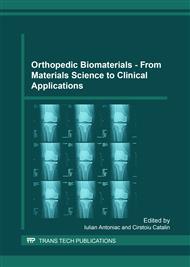[1]
Morrey BF, The elbow and its disorders, 3rd ed. Philadelphia: Saunders; (1993).
Google Scholar
[2]
King GJ, Green DP, Hotchkiss RN, Pederson WC, Wolfe SW. Green's Operative Hand Surgery. London: Churchill Livingston; (2005).
Google Scholar
[3]
Ambacher T, Maurer F, Weise K, Treatment results after primary and secondary resection of the radial head, Unfallchirurg. 103: 6 (2000), 437–443.
Google Scholar
[4]
Beingessner DM, Dunning CE, Gordon KD, Johnson JA, King GJ, The effect of radial head fracture size on elbow kinematics and stability, J Orthop Res. 23: 1 (2005), 210–217.
DOI: 10.1016/j.orthres.2004.06.001
Google Scholar
[5]
Moro JK, Werier J, MacDermid JC, et al., Arthroplasty with a metal radial head for unreconstructible fractures of the radial head, J Bone Joint Surg Am. 83 (2001), 1201–1211.
DOI: 10.2106/00004623-200108000-00010
Google Scholar
[6]
Hotchkiss RN: Displaced fractures of the radial head: Internal fixation or excision. J Am Acad Orthop Surg 5 (1997), 1-10.
Google Scholar
[7]
Smets S, Govaers K, Jansen N, et al., The floating radial head prosthesis for comminuted radial head fractures: a multicentric study, Acta Orthop Belg. 66 (2000), 353–358.
Google Scholar
[8]
Morrey BF, Tanaka S, An KN, Valgus stability of the elbow: a definition of primary and secondary constraints, Clin Orthop Relat Res. 265 (1991), 187–195.
DOI: 10.1097/00003086-199104000-00021
Google Scholar
[9]
Amis AA, Miller JH, Dowson D, Wright V, Biomechanical aspects of the elbow: joint forces related to prosthesis design, Eng Med 10 (1981), 65–68.
DOI: 10.1243/emed_jour_1981_010_021_02
Google Scholar
[10]
King GJ, Adams RA, Morrey BF, Total elbow arthroplasty: revision with use of a non-custom semiconstrained prosthesis, J Bone Joint Surg Am 79 (1997), 394-400.
DOI: 10.2106/00004623-199703000-00012
Google Scholar
[11]
Morrey BF, Adams RA, Semiconstrained arthroplasty for the treatment of rheumatoid arthritis of the elbow. J Bone Joint Surg Am 74 (1992), 479-490.
DOI: 10.2106/00004623-199274040-00003
Google Scholar
[12]
Dawson J, Doll H, Boller I, Fitzpatrick R, Little C, Rees J, et al., The development and validation of a patient-reported questionnaire to assess outcomes of elbow surgery, J Bone Joint Surg Br 90 (2008), 466-473.
DOI: 10.1302/0301-620x.90b4.20290
Google Scholar
[13]
Sathyamoorthy P, Kemp GJ, Rawal A, Rayner V, Frostick SP, Development and validation of an elbow score, Rheumatology 43 (2004), 1434-1440.
DOI: 10.1093/rheumatology/keh367
Google Scholar
[14]
The B, Reininga IH, El Moumni M, Eygendaal D, Elbow-specific clinical rating systems: extent of established validity, reliability, and responsiveness, J Shoulder Elbow Surg 22 (2013), 1380-1394.
DOI: 10.1016/j.jse.2013.04.013
Google Scholar
[15]
Ware JE Jr, Sherbourne CD, The MOS 36-item short-form health survey (SF-36). I. Conceptual framework and item selection, Med Care 30 (1992), 473-483.
DOI: 10.1097/00005650-199206000-00002
Google Scholar
[16]
Schneeberger A., Kosters M., Steens W., Comparison of the subjective elbow value and the Mayo Elbow Performance Score, J Shoulder Elbow Surg 23 (2014), 308-312.
DOI: 10.1016/j.jse.2013.11.018
Google Scholar
[17]
Antoniac I., Biologically responsive biomaterials for tissue engineering, Springer, New York (2013).
Google Scholar
[18]
Niculescu M, Laptoiu D, Miculescu F, Antoniac I, Metal allergy and other adverse reactions in patients with total hip replacement, Advanced Materials Research, 1114 (2015), 283-287.
DOI: 10.4028/www.scientific.net/amr.1114.283
Google Scholar


